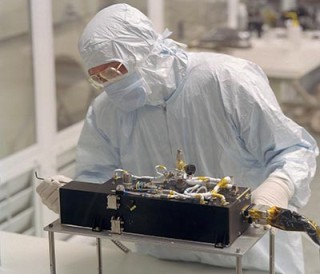Jun 4 2015
A close-up of Comet 67P/Churyumov-Gerasimenko by NASA's ultraviolet instrument surprised scientists by revealing that electrons close to the comet's surface -- not photons from the Sun as had been believed -- cause the rapid breakup of water and carbon dioxide molecules spewing from the surface.
 NASA's Alice ultraviolet (UV) spectrograph, seen here during construction, is aboard the European Space Agency's Rosetta spacecraft. Image Courtesy of Southwest Research Institute
NASA's Alice ultraviolet (UV) spectrograph, seen here during construction, is aboard the European Space Agency's Rosetta spacecraft. Image Courtesy of Southwest Research Institute
Since last August, the European Space Agency's Rosetta spacecraft has orbited within a hundred miles of the comet in this historic mission. The spectrograph onboard, named Alice, specializes in the far-ultraviolet wavelength band and was developed by Southwest Research Institute (SwRI). Alice examines light the comet is emitting to understand the chemistry of the comet's atmosphere, or coma. A spectrograph is a tool astronomers use to split light into its various colors. Scientists can identify the chemical composition of gases by examining their light spectrum. Alice is the first such far-ultraviolet spectrograph to operate at a comet.
"The discovery we're reporting is quite unexpected," said Alice instrument Principal Investigator Dr. Alan Stern, an associate vice president in SwRI's Space Science and Engineering Division. "It shows us the value of going to comets to observe them up close, since this discovery simply could not have been made from Earth or Earth's orbit with any existing or planned observatory. And, it is fundamentally transforming our knowledge of comets.
"Analysis of the relative intensities of observed atomic emissions allows us to determine that we are directly observing the 'parent' molecules that are being broken up by electrons in the immediate vicinity, about 1 kilometer, of the comet's surface from which the parent molecules are vaporizing," said Dr. Paul Feldman, professor of physics and astronomy at the Johns Hopkins University in Baltimore, Maryland.
Feldman is lead author of the paper, "Measurements of the Near-nucleus Coma of Comet 67P/Churyumov-Gerasimenko with the Alice Far-ultraviolet Spectrograph on Rosetta," which has been accepted for publication in the journal, Astronomy and Astrophysics.
Much of the water and carbon dioxide originates from "plumes" erupting from the comet's surface, similar to those that the Hubble Space Telescope discovered on Jupiter's moon Europa, noted co-author Dr. Joel Parker, an assistant director in SwRI's Space Science and Engineering Division's Boulder, Colo., office.
Based on the new Alice data reported in the paper, the explanation for the breakup of those molecules is similar to that for the plumes on Europa, except that the electrons at the comet are produced by solar radiation, while the electrons at Europa come from Jupiter's magnetosphere, Feldman said.
Parker added, "By looking at the emission from hydrogen and oxygen atoms broken from the water molecules, we also can actually trace the location and structure of water plumes from the surface of the comet."
The far-ultraviolet region of the spectrum allows scientists to detect the most abundant elements in the universe: hydrogen, oxygen, carbon and nitrogen. However, Feldman noted such measurements must be made from outside the Earth's atmosphere, either from orbiting observatories such as the Hubble Space Telescope, or from planetary missions such as Rosetta. From Earth's orbit, the atomic constituents can only be seen after their "parent" molecules, such as water and carbon dioxide, have been broken up by sunlight, hundreds to thousands of kilometers away from the nucleus of the comet.
The Alice spectrograph aboard Rosetta has also studied the surface of Comet 67P/ Churyumov-Gerasimenko and will be used in further studies of its atmosphere as the comet approaches the Sun and its plumes become more active due to solar heating.
Rosetta-Alice is one of two ultraviolet spectrographs named "Alice" currently flying in space. The other is New Horizons-Alice. Rosetta-Alice is operated by SwRI under contract with the Jet Propulsion Laboratory/California Institute of Technology for the National Aeronautics and Space Administration. Alice is studying the coma and surface of Comet 67P/Churyumov-Gerasimenko to understand the formation and evolution of comets and the nature of cometary activity, and to connect activity of the nucleus with changes in the coma and tail, as well as interactions with the solar wind.